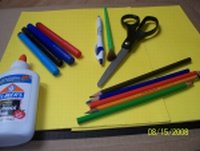Lapbook on
Cells
A Focused Life
Science Study on Cells
He has
learned this rule instructed by
God. Isaiah 28:26
Welcome
to Life Science review Lapbook on Cells. Join in or follow
along as my children and I create a lapbook on cells as part of our
Biology curriculum.
Most
lapbooks can be created in a few hours or in an afternoon of
concentrated work. However, I want to spread out our study over a 5 day
school week. This is part of our summer studies and a conclusion to our
last school year. By doing this lapbook it will refresh the topic and
review the important items.
Another benefit I expect is if they
didn't catch something or understand it the first time, this new
presentation of the materials in a lapbook format, will give them
another opportunity to "get it".
Hopefully, this process will help you create your
own Lapbook Cells or inspire you to try lapbooking a topic of your
choice.
Lapbook on Cells Day 1
Step
1: Gather materials needed for each child.

Step 2: Gather needed information and
identify areas of focus.
For this lapbook our area of focus is Cells. We will want to identify
different types of cells and their components and component functions.
An older student could also include in this lapbook information on Cell
Division and Material Transport.
I also want to add some fun
elements. For my artistic child I may let him draw, color or paint, a
plant or animal cell. Or for my creative, technical child, I may have
him create a Cell game.
Of course, vocabulary is important and I will want
to include some type of vocabulary list with definitions.
To
gather information I will visit trusted online sources and the library.
I will also pull out several Biology texts from our school books. If I
need more resources, I will check with homeschooling friends, visit
rummage sales and thrift stores and any local book sales. The material
I gather will be from basic information on cells to the most complex I
can find.
One amazing site on Cells that I have found is
called the Tree
of Life.
This site presents models of cells in an interactive format. I will let
the children "play" around on the model while I gather the supplies.
Lapbook on Cells Day 2
Step 1:
Assemble lapbook folders.
Step 2:
Create Vocabulary List *See below for suggested
list*
Step 3:
Identify depth of material to be taught
Step 4:
Teach
material for the day....generally about 5-15 minutes worth of material.
A goo place to begin is with the cell structures and organelles.
Step 5:
Allow
students to illustrate or write (using the template or format of their
choice) about two key cell components. If the student creates a
paragraph on the computer and prints it out on a full sheet of paper
that paper can be folded in half and the student can label and decorate
the outside area that will not be glued down.
Or allow students
to draw and label an animal and a plant cell.If you want to add a built
in testing feature...have the student create a simple rectangular fold
with the label on top and on the inside include the definition.
Allow students to paste their creations into the
lapbook.
Lapbook on Cells Day 3
Step 1
Today have
the students create and study the vocabulary lists.Usually about 10
words is good for one session. This can be adapted to the students
abilities and age. Each day another list can be added.
Step 2
While
the students are working on the vocabulary I will gather information
about the cell life cycle or about how things move in and out of a
cell.
Step 3
Teach cell cycle or material exchange.
Step 4
Allow students to illustrate or write about
today's lesson. Finish by gluing into lapbook.
Step 5
Review all material in lapbook.
Day
4
Repeat steps from Day 3 doing the alternate lesson.
Remember to review all material at the end and if
possible in the beginning of the next session.
Day 5
At this point, if all the material has been
covered, I would assign a fun project.
Make up a Cell transport game.
Write a poem about Osmosis or about the Nucleus or
one of the other functions or organelles.
Get out the markers, paints, color pencils and let
them create an cellular image.
Finally, review all material.
Lapbook on Cells Vocabulary
1. Cell
2. Cell Membrane
3. Cell Wall
4. Nucleus
5. Chromosomes
6. Ribosomes
7. Golgi Bodies
8. Vacuoles
9. Chloroplasts
10. Cytoplasm
11. Mitochondria
12. Flagella
13. Cilia
14. Cell Theory
15. Cytoskeleton
Advanced
Vocabulary
1. Diffusion
2. Osmosis
3. Isotonic
4. Hypotonic
5. Hypertonic
6. Endocytosis
7. Exocytosis
8. Phagocytosis
9. Active Transport
10. Bulk Flow
11. Phospholipid Bilayer
12. Proteins
13. Lipids
14. Carbohydrates
15. Hydrostatic Pressure
Advanced Vocabulary List 2
1. Mitosis
2. Chromatids
3. Centromere
4. DNA
5. RNA
6. Prophase
7. Metaphase
8. Anaphase
9. Telophase
10. Cytokinesis
11. Cell Division
From Lapbook
on Cells to Home Page
Don't forget to sign up for the
free, monthly Homeschool Seeker Newsletter.
You'll get more ideas
and
suggestions to help you homeschool. You will also receive a free health guide
and each month features a
mini lapbook.


|





